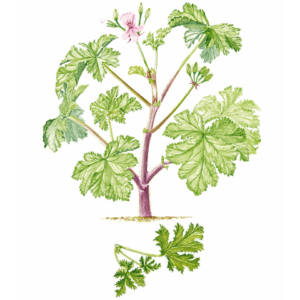
Find out more about the Scented Geranium plant of our Aromatherapy Herbarium blog series.

SCENTED GERANIUM
Rose Geranium
Pelargonium x asperum
DESCRIPTION

Scented geranium, also called rose geranium (Pelargonium x asperum cv. Egypt), is a subshrub of the family of the Geraniaceae, native to Southern Africa.
ADVICE
The use of essential oil of rose geranium does not replace an anti-diabetic treatment. The treatment must not be modified under any circumstance.
DO NOT USE IN
– pregnant or breast-feeding women,
– children under the age of six years (ketones),
– subjects with epilepsy (ketones),
– persons allergic to one of the components (geraniol, linalool, limonene),
– subjects with asthma without the advice of an allergologist before the first use.
RECIPES
Anti-stretch marks
50 drops of EO of rose geranium, 150 ml of borage oil. Mix the oils and apply them on the zones confirmed with gentle massage.
Anti-ageing
Mix every evening 1 drop of essential oil of rose geranium with your dose night cream.
Slimming
10 drops of EO of rose geranium, 30 drops of macadamia CO. Massage the zones concerned with 5 drops of the mixture, once to twice daily.
Mycoses
2 drops of EO of rose geranium, 20 drops of sweet almond CO. Apply by massaging the zone concerned.

Its long green three-lobed leaves with reddish veins are highly indented and velvety. The buds are pinkish; the small flowers white or purple, with five petals of which two have red striations. Few plants are so widespread and universally admired as geraniums, of which there are about a hundred species, all scented but with very diverse scents, that are a pleasure to harvest leaves and flowers throughout the year. Geraniums are named in the countryside Herb Robert, fourchette du diable or cranesbill. This last name alludes to the shape of its fruit which resembles a tapered beak, thus the scientific names: pelargonium derives from the Greek pelargos (stork) and geranium from geranos (crane). The wild form existed in Antiquity, but it was only cultivated from its arrival in Europe at the end of the 17th century. It was first implanted in Bourbon island, nowadays Reunion island. Geranium was used in the past as a medicinal plant to treat ophthalmia, excessive milk production, swelling of the throat due to tonsil inflammation and the violent sore throat referred to as tonsillitis. Scented geraniums are found in some famous perfumes: “Jazz” by Yves Saint Laurent, “Brut” by Fabergé, “Caleche” by Hermès and “Egoiste” by Chanel.
CULTIVATION AND PRODUCTION
China has become the first producer and exporter of rose geranium, which is also cultivated in Morocco and Egypt. It was introduced in Reunion island about 1870, from South Africa, and more recently in Madagascar, that produces an essential oil of exceptional quality.
FRAGRANCE
The odour of rose geranium, discrete, soft and sweet is reminiscent of that of roses. This is why it often replaces that essential oil which is much more expensive.
EXTRACTION AND YIELD
Essential oil of rose geranium is extracted by distillation of the leaves, with a yield of 0.15% to 0.25%, i.e. one hundred and fifty to two hundred and fifty grams per hundred kilograms of plant.
CHEMICAL FORMULA
The main components of essential oil of rose geranium are in particular monoterpenes, sesquiterpenes, monoterpenols (citronellol, geraniol) and esters (geranyl acetate).
MAIN INDICATIONS
An antibacterial and anti-mycotic, essential oil of rose geranium favours healing. It firms up the skin and has a purifying action on all types of skin problems: acne, eczema, itching, impetigo, etc. It is effective against a great number of urinary, intestinal or pulmonary infections, it helps against cellulite, water retention and excess weight. It is a repellent and drives insects away as well.


Leave a Comment